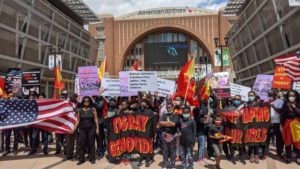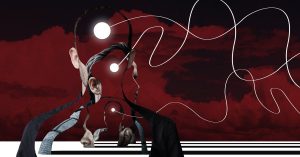Tourists flock to South Dakota’s massive presidential portraits. How they got there is a complex tale of land grabs, egos, and foiled movie scenes.
Built on sacred Native American land and sculpted by a man with ties to the Ku Klux Klan, Mount Rushmore National Memorial was fraught with controversy even before it was completed 79 years ago on October 31, 1941.
Mount Rushmore pays patriotic tribute to four United States presidents—George Washington, Thomas Jefferson, Theodore Roosevelt, and Abraham Lincoln—with 60-foot-tall faces carved into a mountainside in the Black Hills of South Dakota.
Over the years, the monument has drawn protests over its location on indigenous land, debates about whether another commander-in-chief deserves a spot on the mountain, and a Hollywood controversy over an Alfred Hitchcock movie partially filmed on the site.
To understand how Mount Rushmore has become a cultural symbol and flash point, here’s a look at how the memorial came to be.
STOLEN LAND
Before it became known as Mount Rushmore, the Lakota called this granite formation Tunkasila Sakpe Paha, or Six Grandfathers Mountain. It was a place for prayer and devotion for the Native people of the Great Plains, explains Donovin Sprague, head of the history department at Sheridan College in Wyoming and a member of the Cheyenne River Sioux Tribe. The mountain’s location in the Black Hills was also significant.
“It’s the center of the universe of our people,” Sprague says. For Lakota, Cheyenne, and Arapaho communities, the region was not only spiritually important, it was also where tribes gathered food and plants they used in building and medicine.
In the late 1800s, Euro-American settlers began pushing into the Black Hills, igniting a war with the indigenous population. The U.S. government signed the Treaty of Fort Laramie in 1868, giving the Lakota exclusive use of the Black Hills. Within a decade, however, gold was discovered in the region and, in 1877, the U.S. broke the treaty and took over the land.
“What happened with the Black Hills is so clearly theft in relation to the U.S.’s own laws,” says Christine Gish Hill, a professor of anthropology at Iowa State University who has investigated the meaning of Mount Rushmore for Native Americans.
After that, settlers and prospectors poured into the region. In 1884, New York attorney Charles Rushmore visited to strike a deal on a tin mine, and, on a lark, Six Grandfathers was renamed after him.
But the land dispute was not resolved. In the 1920s, the Lakota tribes sued the U.S. government for theft—a legal battle that would drag on for decades.
CREATING A TOURIST ATTRACTION
By the 1920s, South Dakota, now a U.S. state, had became a road-trip destination for Americans in their new horseless carriages. They motored in to see the newly designated Black Hills National Forest and Wind Cave National Park. Governor Peter Norbeck had also built the Needles Highway, a scenic route wending through the iconic granite formations of the Black Hills.
But Doane Robinson, a historian at the South Dakota State Historical Society, believed the state needed more to entice tourists. In 1924, learning about an attempt to carve the likenesses of Confederate leaders into the side of Stone Mountain in Georgia, Robinson launched a campaign to create South Dakota’s own mountain men.
Robinson envisioned an ode to the old West, with carvings of historic figures such as Lewis and Clark and Lakota leader Red Cloud. He reached out to Stone Mountain sculptor Gutzon Borglum—who would transform the granite mountain into what it is today.
A CONTROVERSIAL SCULPTOR
Borglum had gained fame for sculptures honoring U.S. history—as well as his bombastic personality. In Georgia, he became involved with the Ku Klux Klan, which helped fund the Stone Mountain project. But Borglum soon began to clash with the Stone Mountain Memorial Association.
In February 1925, the association fired Borglum, citing mismanagement of funds and “his offensive egotism and his delusions of grandeur.” His sacking made national news when Borglum destroyed the Stone Mountain models and fled the state.
By August 1925, Borglum had agreed to work on Mount Rushmore—but not the way Robinson had pitched it. Borglum saw the carving as a testament to American exceptionalism, and advocated that it depict presidents instrumental in the country’s expansion.
George Washington, the country’s first president, would represent its birth. Thomas Jefferson, who nearly doubled the country’s size with his purchase of the Louisiana Territory, stood for its westward expansion. Theodore Roosevelt, who had overseen the construction of the Panama Canal, was a symbol of economic growth. And Abraham Lincoln was selected for having fought to preserve the nation in the Civil War.
UNFINISHED WORK, A SECRET ROOM, AND POP CULTURE DEPICTIONS
Over the next 16 years, Borglum wrangled with the federal government about funding and control of Mount Rushmore—which he never technically completed.
Borglum hoped to carve the presidents down to their waists and chisel a description of the memorial next to them. But when it became clear there wasn’t enough space for the latter, he decided to build a room behind the faces to hold U.S historical artifacts.
In 1938, Borglum began blasting a 70-foot tunnel into the mountain for his Hall of Records. Worried about funding as war loomed in Europe, however, the U.S. government ultimately instructed Borglum to hold off on the hall until the four faces had been completed.
Borglum was still refining those heads when his health began to deteriorate. He died on March 6, 1941, leaving his son, Lincoln, to continue his work. But the mountain had a limited amount of carvable surface—for example, Jefferson’s hand couldn’t be completed due to the quality of the stone—and, worse, funding had run out. The project was declared finished on October 31, 1941.
The tunnel that Borglum had drilled for the Hall of Records sat empty for decades until 1998, when the National Park Service placed a titanium vault in the floor, filling it with information on Mount Rushmore, the presidents, and U.S. history. This not-so-secret room isn’t open to the public but has been the subject of much speculation and was even depicted in the National Treasure fictional historical conspiracy movies.
Mount Rushmore was most famously the setting of the final chase scene in Alfred Hitchcock’s 1959 thriller North by Northwest. However, the filming itself sparked a controversy. In 1958, the National Park Service granted Hitchcock permission to film at the memorial on the condition that it wouldn’t serve as the backdrop for any violent scenes. Hitchcock had to promise Cary Grant and other actors wouldn’t run across the tops of the presidents’ heads.
Hitchcock partially kept his promise, filming scenes in the memorial’s parking lot and cafeteria. He then went on to shoot the film’s violent final chase scene on a scaled replica so realistic that viewers believed it was filmed at Mount Rushmore. The National Park Service and the U.S. Department of the Interior cried foul, and ultimately asked Metro-Goldwyn-Mayer to remove the credit line at the end of the movie thanking them for their cooperation.
A SITE FOR PROTEST
Mount Rushmore opened to the public even as the Lakota continued legal challenges. In the decades since, the memorial and its surroundings have served as a flash point for the treatment of Native Americans.
Although the loss of the land was a far bigger concern for many Lakota, Cheyenne, and Arapaho, Hill says that some indigenous people wanted the site to recognize their history, too.
Native nations have also taken issue with the way Mount Rushmore told their story—and that of U.S. expansion. Borglum had envisioned the site as a shrine to the greatness of the four presidents it depicted—and as a result, Hill says, the memorial became “a space for uncomplicated patriotism.”
Mount Rushmore’s interpretation of U.S. history ignored that Roosevelt, for example, oversaw the dismantling of Indian Territory in Oklahoma, while Washington and Jefferson owned enslaved Africans. As Sprague points out, even Lincoln was enthusiastic about western expansion and, in 1862, dispatched U.S. troops to Minnesota to put down a Dakota uprising.
The civil rights movement of the 1960s inspired a wave of protest among Native Americans across the country. In the summer of 1970, protest came to Mount Rushmore when a few dozen activists from the organization United Native Americans scaled the memorial to demand the return of the Black Hills to the Lakota. They camped atop the memorial for months—and then returned the following summer for a briefer protest that ended in their arrests.
In 1980, the long-running legal dispute finally reached the U.S. Supreme Court. In the landmark United States v. Sioux Nation of Indians case, the Supreme Court ruled that the U.S. government had improperly taken the Black Hills territory from the Lakota, who were deemed entitled to $17.1 million in damages. But the Lakota declined the compensation and have since advocated for the return of the Black Hills instead.
Mount Rushmore’s duality—sacred indigenous ground, patriotic bucket-list destination—means it remains a protest site today. On July 4, 2020, more than a hundred demonstrators gathered at a Fourth of July rally held by President Donald Trump to protest the memorial and remind attendees that it was built on stolen land.
PROPOSALS FOR CHANGE
Forces began campaigning to add faces to Mount Rushmore while the monument was still under construction. First Lady Eleanor Roosevelt supported an unsuccessful 1936 proposal to put women’s rights activist Susan B. Anthony on the rock. The idea that the memorial could somehow evolve would live on, with political partisans over the years suggesting adding John F. Kennedy, Ronald Reagan, and Franklin Delano Roosevelt. More recently, Trump has repeatedly crowed that he should be on the list.
While some have pushed for Mount Rushmore to be expanded, others have demanded that it to be torn down. As the U.S. continues to reckon with the Confederate statues and other monuments to its racist past, some tribal leaders and their supporters have called for the removal of the memorial.
It’s unlikely that any major changes will be made to this nearly 80-year-old memorial. The National Park Service has dismissed the idea of altering Borglum’s vision to include a new face, while the Native American community is divided on the question of whether to destroy it or use it to educate tourists about the real history of the American West.
“I don’t see anything to gain from tearing things down, but where I’m coming from is to have a side of the American Indian or Lakota people there,” Sprague says. “A massive number of people visit this grand carving but they walk away with very little knowledge about these things.”
Amy McKeever is a senior writer and editor at National Geographic. Follow her on Instagram.




